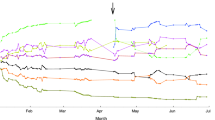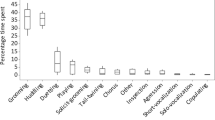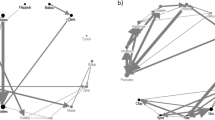Abstract
In social organizations characterized by male philopatry, social relationships between males are argued to be the strongest. Little is known about the social relationships of philopatric male spider monkeys. To address this limitation, we investigated social relationships among individually recognized wild adult male spider monkeys from two well-habituated communities in the Yucatan Peninsula, Mexico, focusing on affiliative behaviors important in regulating male social relationships, including grooming, embracing, arm-wrapping, and grappling. We examined whether behaviors were reciprocated between male partners and whether age was a factor in how the behaviors were distributed or reciprocated, by examining differences between younger adult males (<10 years) and older adult males (≥14 years). Although we found evidence that affiliative behaviors were overall reciprocated between spider monkey adult males, there were pronounced differences in the interactions depending on their relative age. Reciprocation in grooming and embraces between same-age males suggests their relationships are valuable to both partners. Among different-age dyads, younger males gave more embraces than they received, were the initiators of grappling and arm-wrapped more often than with same-age males, suggesting relationships between younger and older males are more risky. This confirms that younger males are attracted to older males, probably because they value relationships with older males more than the reverse, but they are also at risk.



Similar content being viewed by others
References
Ahumada JA (1992) Grooming behavior of spider monkeys (Ateles geoffroyi) on Barro Colorado Island, Panama. Int J Primatol 13:33–49
Aureli F, Schaffner CM (2007) Aggression and conflict management at fusion in spider monkeys. Biol Lett 3:147–149
Aureli F, Schaffner CM (2008) Spider monkeys: social structure, social relationships and social interactions. In: Campbell C (ed) Spider monkeys: behavior ecology and evolution of the genus Ateles. Cambridge University Press, Cambridge, pp 236–265
Aureli F, Schaffner CM, Verpooten J, Slater KY, Ramos-Fernandez G (2006) Raiding parties of male spider monkeys: insights into human warfare? Am J Phys Anthropol 131:486–497
Campbell CJ (2006a) Copulatory behavior of free ranging black-handed spider monkeys (Ateles geoffroyi). Am J Primatol 68:507–511
Campbell CJ (2006b) Lethal intragroup aggression by adult male spider monkeys (Ateles geoffroyi). Am J Primatol 68:1197–1201
Campbell CJ, Gibson KN (2008) Spider monkey reproduction and sexual behavior. In: Campbell C (ed) Spider monkeys: behavior ecology and evolution of the genus Ateles. Cambridge University Press, Cambridge, pp 266–287
Chapman CA (1990) Association patterns of spider monkeys: the influence of ecology and sex on social organization. Behav Ecol Sociobiol 26:409–414
Colmenares F, Hofer H, East ML (2000) Greeting ceremonies in baboons and hyenas. In: Aureli F, de Waal FBM (eds) Natural conflict resolution. University of California Press, Los Angeles, pp 94–96
Cords M, Aureli F (2000) Reconciliation and relationship qualities. In: Aureli F, de Waal FBM (eds) Natural conflict resolution. University of California Press, Los Angeles, pp 177–198
Davis N, Schaffner CM, Wehnelt S (2009) Patterns of aggression in zoo-housed spider monkeys: a problem with males? Appl Anim Behav Sci 116:250–259
de Waal FBM (1982) Chimpanzee politics. Cape, London
de Waal FBM, Luttrell LM (1988) Mechanisms of social reciprocity in three primate species: symmetrical relationship characteristics or cognition? Ethol Sociobiol 9:101–118
Di Fiore A, Fleischer RC (2005) Social behaviour, reproductive strategies, and population genetic structure of Lagothrix poeppigii. Int J Primatol 26:1137–1173
Di Fiore A, Link AL, Schmitt CA, Spehar SN (2009) Dispersal patterns in sympatric woolly and spider monkeys: integrating molecular and observational data. Behaviour 146:437–447
Di Fiore A, Link A, Campbell CJ (2011) The atelines: behavior and socioecological diversity in a New World monkey radiation. In: Campbell CJ, Fuentes AF, MacKinnon KC, Bearder S, Stumpf R (eds) Primates in perspective. Oxford University Press, Oxford, pp 155–188
Dunbar RIM (1991) Functional significance of social grooming in primates. Folia Primatol 57:121–131
Fedigan LM, Baxter MJ (1984) Sex differences and social organization in free-ranging spider monkeys (Ateles geoffroyi). Primates 25:279–284
Gibson KN (2010) Male mating tactics in spider monkeys: sneaking to compete. Am J Primatol 72:794–804
Gomes CM, Boesch C (2009) Wild chimpanzees exchange meat for sex on a long-term basis. PLoS ONE 4:e5116. doi:10.1371/jounal.pone.0005116
Goodall J (1986) The chimpanzees of Gombe. Harvard University Press, Cambridge
Hart BL, Hart LA (1992) Reciprocal allogrooming in impala, Aepyceros melampus. Anim Behav 44:1073–1083
Hill RA, Dunbar RIM (1998) An evaluation of the roles of predation rate and predation risk as selective pressures on primate grouping behaviour. Behaviour 135:411–430
Hrdy SB, Janson C, van Schaik CP (1995) Infanticide: let’s not throw out the baby with the bath water. Evol Anthropol 3:151–154
Janson CH (1998) Testing the predation hypothesis for vertebrate sociality: prospects and pitfalls. Behaviour 135:389–410
Klein LL (1974) Agonistic behavior in neotropical primates. In: Holloway RL (ed) Primate aggression, territoriality and xenophobia: a comparative perspective. Academic Press, New York, pp 77–122
Klein LL, Klein DJ (1971) Aspects of social behaviour in a colony of spider monkeys Ateles geoffroyi at San Francisco Zoo. Int Zoo Yrbk 11:175–181
Kutsukake N, Suetsugu N, Hasegawa T (2006) Pattern, distribution, and function of greeting behaviour among black-and-white colobus. Int J Primatol 27:1271–1291
Lehmann J, Boesch C (2008) Sex differences in chimpanzee sociality. Int J Primatol 29:65–81
Mitani JC (2006) Reciprocal exchanges in chimpanzees and other primates. In: Kappeler PM, van Schaik CP (eds) Cooperation in primates and humans. Springer, Berlin, pp 107–119
Mitani JC (2009) Male chimpanzees form enduring and equitable social bonds. Anim Behav 77:633–640
Newton-Fisher NE (1999) Association by male chimpanzees: a social tactic? Behaviour 136:705–730
Nishida T (1983) Alpha status and agonistic alliances in wild chimpanzees (Pan troglodytes schweinfurthii). Primates 24:318–336
Pastor-Nieto R (2001) Grooming, kinship, and co-feeding in captive spider monkeys (Ateles geoffroyi). Zoo Biol 20:293–303
Pepper JW, Mitani JC, Watts DP (1999) General gregariousness and specific social preferences among wild chimpanzees. Int J Primatol 20:613–632
Pusey AE (1980) Inbreeding avoidance in chimpanzees. Anim Behav 28:543–582
Ramos-Fernandez G (2005) Vocal communication in a fission-fusion society: do spider monkeys stay in touch with close associates? Int J Primatol 26:1077–1092
Ramos-Fernandez G, Vick LG, Aureli F, Schaffner CM, Taub DM (2003) Behavioral ecology and conservation status of spider monkeys in the Otoch Ma’ax Yetel Kooh protected area. Neotrop Primates 11:155–158
Rebecchini L, Schaffner CM, Aureli F (2011) Risk is a component of social relationships in wild spider monkeys. Ethology 117:691–699. doi:10.1111/j.1439-0310.2011.01923.x
Romero T, Aureli F (2008) Reciprocity of support in coatis. J Comp Psychol 122:19–25
Schaffner C, Aureli F (2005) The role of embraces and grooming in captive spider monkeys. Int J Primatol 26:1093–1106
Schino G (2007) Grooming and agonistic support: a meta analysis of primate reciprocal altruism. Behav Ecol 18:115–120
Schino G, Aureli F (2008) Grooming reciprocation among female primates: a meta analysis. Biol Lett 4:9–11
Schino G, Aureli F (2009) Reciprocal altruism in primates: partner choice, cognition and emotions. Adv Study Behav 39:45–69
Schino G, Ventura R, Troisi A (2003) Grooming among female Japanese macaques: distinguishing between reciprocation and interchange. Behav Ecol 14:887–891
Shimooka Y (2003) Seasonal variation in association patterns of wild spider monkeys (Ateles belzebuth belzebuth) at La Macarena, Colombia. Primates 44:83–90
Shimooka Y (2005) Sexual differences in ranging of Ateles belzebuth belzebuth at La Macarena, Colombia. Int J Primatol 26:385–406
Shimooka Y, Campbell CJ, Di Fiore A, Felton AM, Izawa K, Link A, Nishimura A, Ramos-Fernandez G, Wallace R (2008) Demography and group composition of Ateles. In: Campbell C (ed) Spider monkeys: behavior ecology and evolution of the genus Ateles. Cambridge University Press, Cambridge, pp 329–348
Silk JB (1992) The patterning of intervention among male bonnet macaques: reciprocity, revenge, and loyalty. Curr Anthropol 33:318–325
Silk JB, Alberts SC, Altmann J (2003) Social bonds of female baboons enhance infant survival. Science 302:1231–1234
Silk JB, Alberts SC, Altmann J (2006) Social relationships among adult female baboons (Papio cynocephalus) II: variation in the quality and stability of social bonds. Behav Ecol Sociobiol 61:197–204
Silk JB, Beehner JC, Bergman TJ, Crockford C, Engh AL, Moscovice LR, Wittig RM, Seyfarth RM, Cheney DL (2010a) Female chacma baboons form strong, equitable, and enduring social bonds. Behav Ecol Sociobiol 64:1733–1747
Silk JB, Beehner JC, Bergman TJ, Crockford C, Engh AL, Moscovice LR, Wittig RM, Seyfarth RM, Cheney DL (2010b) Strong and consistent social bonds enhance the longevity of female baboons. Curr Biol 20:1359–1361
Slater KY, Schaffner CM, Aureli F (2007) Embraces for infant handling in spider monkeys: evidence for a biological market? Anim Behav 74:455–461
Slater KY, Schaffner CM, Aureli F (2009) Sex differences in the social behaviour of wild spider monkeys. Am J Primatol 71:21–29
Strier KB (1994) Brotherhoods among atelins: kinship, affiliation and competition. Behaviour 130:151–167
Strier KB, Dib LT, Figueira JT (2002) Social dynamics of male muriquis (Brachyteles arachnoids hypoxanthus). Behaviour 139:315–342
Symington MM (1988) Demography, ranging patterns, and activity budgets of the black spider monkey (Ateles paniscus chamek) in the Manu national park, Peru. Am J Primatol 15:45–67
Symington MM (1990) Fission–fusion social organisation in Ateles and Pan. Int J Primatol 11:47–61
Tabachnick BG, Fidell LS (2007) Using multivariate statistics. Pearson Education, Inc, Boston
Tiddi B, Aureli F, Polizzi di Sorrentino E, Janson CH, Schino G (2011) Grooming for tolerance? Two mechanisms of exchange in wild tufted capuchin. Behav Ecol 22:663–669
Trivers RL (1971) The evolution of reciprocal altruism. Q Rev Biol 46:35–57
Valero A, Schaffner CM, Vick LG, Aureli F, Ramos-Fernandez G (2006) Intragroup lethal aggression in wild spider monkeys. Am J Primatol 68:732–737
van Roosmalen MGM, Klein LL (1988) The spider monkeys, genus Ateles. In: Mittermeier RA, Coimbra-Filho AF, de Fonseca GAB (eds) Ecology and behavior of neotropical primates, vol 2. World Wildlife Fund, Washington, DC, pp 455–537
van Schaik CP (2000) Social counterstrategies against infanticide by male in primates and other mammals. In: Kappeler PM (ed) Primate males. Cambridge University Press, Cambridge, pp 34–54
Vick LG (2008) Immaturity in spider monkeys: a risky business. In: Campbell C (ed) Spider monkeys: behavior ecology and evolution of the genus Ateles. Cambridge University Press, Cambridge, pp 288–328
Wallace RB (2008) Towing the party line: territoriality, risky boundaries and male group size in spider monkey fission–fussion societies. Am J Primatol 70:271–281
Watts DP (1998) Coalitionary mate guarding by male chimpanzees at Ngogo, Kibale National Park, Uganda. Behav Ecol Sociobiol 44:43–55
Watts DP (2000) Grooming between male chimpanzees at Ngogo, Kibale National Park 1: partner number and diversity and grooming reciprocity. Int J Primatol 21:189–210
Watts DP (2002) Interchange of grooming and coalitionary support by wild male chimpanzees. Behaviour 139:343–370
Watts DP, Mitani JC (2001) Boundary patrols and intergroup encounters in wild chimpanzees. Behaviour 138:299–327
Widdig A, Streich WJ, Tembrock G (2000) Coalition formation among male Barbary macaques (Macaca sylvanus). Am J Primatol 50:37–51
Wrangham RW (1999) Evolution of coalitionary killing. Yrbk Phys Anthropol 42:1–30
Acknowledgments
We thank Pronatura Peninsula de Yucatan, for permission to conduct our research. We are also grateful to Eulogio Canul-Aban, Macedonio Canul-Chan, Augusto Canul-Aban, and Juan Canul-Chan for valuable assistance in the field. We also thank Gabriele Schino for advice on general linear model techniques. In addition, we are appreciative of the comments of three anonymous reviewers whose feedback strengthened our manuscript. We are also grateful to the Punta Laguna community for their support of the ongoing spider monkey project. We also acknowledge The British Academy, the Wenner-Gren Foundation, The National Geographic Society, and the North of England Zoological Society for financial support of the spider monkey project. The University of Chester fully supported the research of KYS and has provided ongoing financial support of the spider monkey project.
Author information
Authors and Affiliations
Corresponding author
About this article
Cite this article
Schaffner, C.M., Slater, K.Y. & Aureli, F. Age related variation in male–male relationships in wild spider monkeys (Ateles geoffroyi yucatanensis). Primates 53, 49–56 (2012). https://doi.org/10.1007/s10329-011-0271-5
Received:
Accepted:
Published:
Issue Date:
DOI: https://doi.org/10.1007/s10329-011-0271-5




